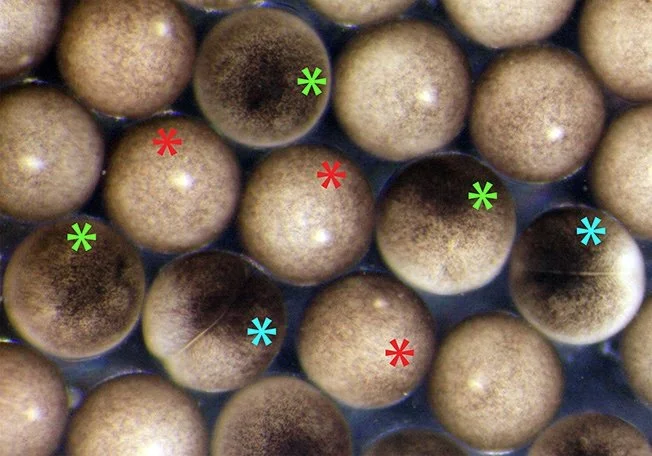Obtaining Embryos
Whenever handling X. tropicalis, we recommend wearing gloves (powder-free). X. tropicalis have been shown to harbor mycobacterial infections. While we have had no instances of laboratory transmission of mycobacterial disease from frogs to humans, we recommend wearing gloves until the mycobacterial infection is fully characterized. Currently, we believe the risk of human infection of mycobacteria from frogs is quite low and the symptoms would be mild (cutaneous ulcer that can be treated with excision). Nevertheless, avoiding infection remains the goal so we recommend gloves as protection. For the protection of the frogs, it is important that the gloves be powder-free.
IVF
How to perform in vitro fertilization and maximize your fertilization rate:
Obtaining Xenopus Tropicalis Embryos by In Vitro Fertilization
Identifying fertilized eggs
Fertilized eggs (green asterisk) rotate so the animal pole faces up. The pigment coalesces at the sperm entry point. Embryos advancing to two cell stage (blue asterisk) develop a cleavage furrow. Unfertilized eggs (red asterisk) do not rotate and pigment remains diffuse.
Image: Fertilized Xenopus Embryos
Surface Sterilizing X. tropicalis Embryos
Obtaining Xenopus Tropicalis Eggs
Obtaining Xenopus Tropicalis Embryos by Natural Mating
Tables of X. tropicalis and X. laevis development at different temperatures: allows the experimentalist to track the developmental stage of embryos over time for particular ambient temperatures.
De-Jelly Embryos: protocol for removing the jelly coats of embryos
HCG Protocols
High Salts Protocols
To prolong the viability of eggs before IVF:

